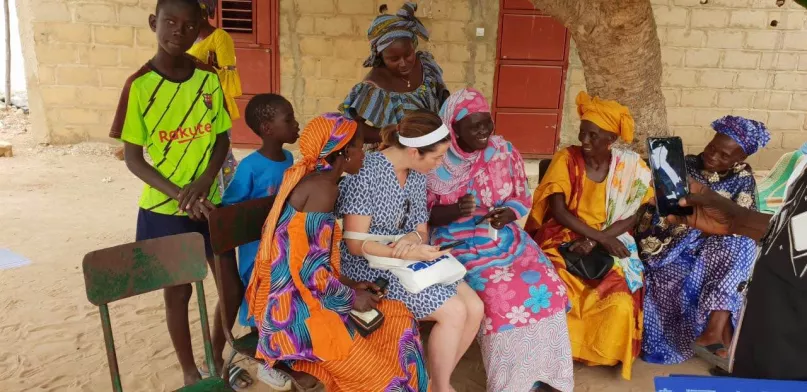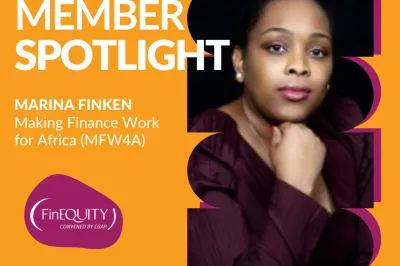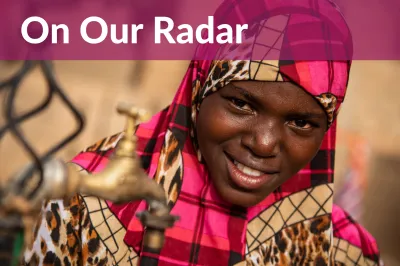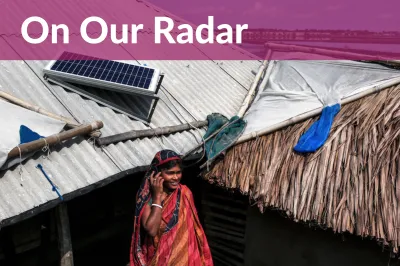Jamie M. Zimmerman, Gender Lead, Financial Services for the Poor, Global Growth & Opportunity Bill & Melinda Gates Foundation

-
How were you drawn to the field of women's financial inclusion?
We have a saying, I dare say a mantra, on the Financial Services for the Poor team: “If you design for all, you’re designing for men.” I’m deeply passionate about financial inclusion as a platform for economic opportunity and empowerment for all, but first and foremost for the historically marginalized and excluded, all those whom the system was not built to empower. When you look at the many inequities and barriers facing women including access to finance, information, tools, rights, and economic opportunity (the list goes on, as we know…), tackling gender equality in financial inclusion naturally becomes paramount. We’ve made tremendous gains in financial inclusion globally over the last decade and yet the gender gap in access has not budged since 2014. Stated more plainly: increased financial access is disproportionately benefiting men. It has become exceedingly clear to me that we must look squarely at the barriers and limitations imposed on women and work to close those gaps in very deliberate way if financial inclusion as a field is to fulfill its promise.
-
Congratulations on your new role as Gender Lead for Global Growth & Opportunity at the Bill & Melinda Gates Foundation. Are you able to share a few thoughts about your outward-facing plans in this position, and also about gender mainstreaming within Gates?
Thank you! I like to joke about how I officially took on the helm of FSP’s Gender Equality work on March 4th, the day Foundation staff were sent home due to COVID, and the day before our annual strategy review with Bill, Melinda and the foundation’s executive leadership. Quite the time to start a new role on the team! On the one hand, COVID disrupted my early plans to onboard into the role, connect with partners and the ecosystem, and start thinking through the future of FSP’s WEE-FI strategy. On the other hand, COVID in many ways has tilted the axis of our team’s (and the entire foundation’s) attention even more squarely towards the need to center women in the work we do.
Several months into it, I’ll share a few priorities that have crystalized for me:
- Centering women in the Build Back Better policy responses to COVID-19. How do you ensure these responses are designed and rolled out in such a way that they help close access gaps while also optimally supporting and economically empowering women? It is possible, but it will take strong partnerships, commitment, and investment to make it happen. Indeed, I believe strongly that if we fail to center women in our responses now, the result will not be gender-neutral: barriers and inequalities will widen for women, particularly those already furthest away from economic and social equality. More on this below.
- Catalyzing DFS as a driver for WEE. There is so much to learn here about levers, accelerators, and barriers that impact the ability of DFS to catalyze women’s economic empowerment. And that means there is also so much opportunity for innovation. For example, I’m really excited about the work of the WEE-DIFINE initiative launched at the BRAC Institute of Governance and Development to generate a comprehensive body of evidence around the impact of DFS on WEE. And our partners on IDEO.org’s Women and Money team have added an exploration of WEE opportunities and challenges at different life stages in order to identify & prioritize opportunities to design better DFS products & services to increase a woman’s agency at life’s pivotal moments.
- Mainstreaming gender throughout FSP. FSP has been working on integrating gender into our investments and partnerships since 2017, and I’m thrilled with our progress: In the last 3 years, we substantially increased the number of gender-intentional and gender-transformative investments. Yet while building gender intentionality into our grants is awesome, our gender goals have stood as a separate strategic pillar on our team. If we want to truly mainstream gender and close gender gaps in access, leadership, and opportunity for all of our partners, then we have a responsibility to do the same. Our aim is to be the first program team at the foundation that has integrated specific, measurable gender goals into each of our focus areas.
-
Thank you for being the opening speaker on DAY 2 of #FinEquity2020. What were your key take-aways at the end of the event?
It was as much a pleasure to share remarks and reflections at this year’s FinEquity meeting as it has been to see FinEquity grow and evolve over the last few years. I learned so much from the breadth, depth, and active engagement of the voices in the various conversations. To me, that is the real power of the community: democratizing and amplifying the voices of those across the women’s financial inclusion field, whether global advocates or grassroots implementers or anything in between. This year, I especially appreciated: 1) participants’ interest in soliciting and sharing feedback on emerging initiatives, 2) reflecting and inputting into FinEquity’s new themes, and 3) FinEquity branching out to have more focused, regional conversations to ensure more context-specific exchanges, amplifying local voices and institutions.
-
What do you feel are the greatest challenges and/or opportunities both for FinEquity and for WFI in the next five years?
To achieve women’s financial inclusion, we have a LOT of work to do which requires an “all hands on deck” approach. Like I said above: “It’s possible, but will take strong partnerships, commitment, and investment.” There is so much complexity and so many intersectional barriers to advancing women’s financial inclusion and empowerment that it’s hard to imagine that simple solutions will do.
Here are three fundamental challenges and tensions I’ve been grappling with:
- Deciding Where and How to Step on the Gas Pedal: We know that gender equality can’t wait, but it requires translating rhetoric and intentions into the necessary investments to close gaps. Where barriers are systemic and gaps seem intractable, we will have to get more comfortable with the possibility that cheap fixes and band-aid solutions will fail, and this will be hard work. But where to focus? Accelerating the pace of change will require focus and prioritization on the most fundamental barriers and enablers. Developing more robust sex-disaggregated data and analytical tools, along with agile monitoring and evaluation would go a long way to cut through the noise to document and focus on what matters most, faster.
- Prioritizing Women in Leadership: It should go without saying, but we also need more women in leadership, and we need to do much better at giving women, including and especially women of color and young women, a seat at the decision-making table at ALL levels, from women’s collectives in the villages to the C-suites of New York and Silicon Valley. Really, I’m talking about all sectors where financial inclusion is at stake, including policymaking, fintech, telecom, banking, regulation and supervision, cybersecurity, academia, and any of the many local, regional, and global governing bodies and civil society institutions. As the late Hon. Ruth Bader Ginsburg said: “Women belong in all places where decisions are being made.”
- Doing Gender Mainstreaming Right: Finally, as so many institutions – including the Foundation – are fortifying their commitments to gender equality and setting their own gender strategies, we must challenge ourselves to get gender mainstreaming right. There is a long history of pink-washing products, policies, and services, or creating “pink ghettos” in institutions where women’s issues are covered, and hence sidelined instead of mainstreamed. True gender mainstreaming is likely to require some fundamental changes in institutional strategies, organizations, and culture. I’d like to see our field building the capabilities, metrics and tools to create lasting change and impact.
-
What is the impact of COVID on your work?
While the COVID-19 crisis has not changed the foundation’s financial inclusion strategy, it has underscored its urgency. COVID has shone a brilliant spotlight on the criticality and urgency of having inclusive digital financial infrastructure and addressing the pandemic’s toll on women.
Through this pandemic, governments have been seeking to contain the health impacts of the COVID-19 outbreak while simultaneously working to limit the economic hardships it has wrought. We have seen governments around the world rapidly adapting social assistance by expanding coverage, increasing benefits and simplifying requirements. They are opting to digitize G2P payments to help facilitate physical distancing and rapidly disburse funds at an unprecedented scale.
Unfortunately, women are at heightened risk of exclusion during the rapid scaling and digitization of cash transfers in response to COVID-19. Seeing this risk as the economic shutdown loomed and cash transfer responses ballooned, we collaborated on a paper with the G2Px team at the World Bank Group, CGAP, Women’s World Banking and Stanford University to raise awareness of these risks and offer concrete policy design options to mitigate exclusion risks and maximize impact on women and girls.
Built off of the D3 Criteria for WFI and WEE through G2P, we advocate for policy makers to take actionable, proactive, and gender-intentional steps now to ensure that vital cash transfers proactively increase women’s control over their personal financial decisions, enhance their prospects for economic recovery and empowerment, and improve their resilience during and well beyond this crisis. Bringing women into the economic fold and enhancing their economic empowerment and resilience will lead to a more pandemic-resilient economy.
Of course, this will require an enormous increase in the capacity of states to identify and enable payments to and among their citizens. Investments in digital retail payment infrastructure, digital ID, distribution infrastructure, and enabling regulation are critical building blocks to establishing this aspect of pandemic resilience. Placing women at the center of these investments will help to ensure that they don’t get further sidelined by the “tyranny of the urgent.”
-
Is there anything you'd like to add?
This year has revealed so much about the pressures and barriers that women face, and I’m as resolved as ever to amplify women’s voices, advocate for policy change, and partner with and learn from institutions driving these changes. FinEquity has been a great source of learning, dialogue, and connection, and I look forward to watching it continue to grow.


